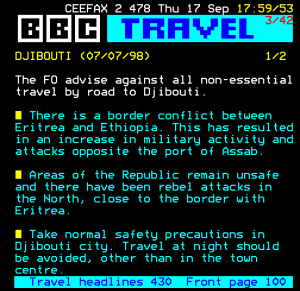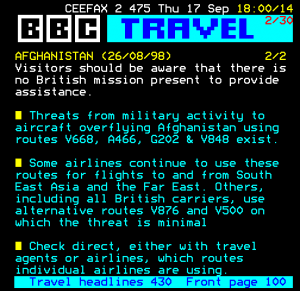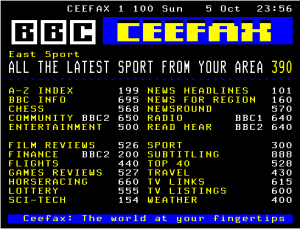Ceefax brought ASCII and block art to the masses,
And a dream to one little boy.
A colleague in the IT business is very fond of ASCII Art, the arrangement of letters, numbers and other symbols from the ASCII character-set to create something that looks vaguely like an image (though perhaps only to the severely visually impaired). Sadly for him (if not for the rest of us) the steady march of technological progress provides him with fewer and fewer opportunities to indulge this particular passion. I’m sure he’ll find another though as it does seem that limiting the tools of artistic expression brings out a defiant and slightly perverse side in some of us; a hard-core few who surely get infinitely more pleasure from the challenge of their creations than those of us who merely witness the results.
 To those of a certain vintage perhaps the best example of this sort of thing was Teletext, known to us in the UK as Ceefax (on the BBC) and Oracle for the independents. Pages from this library of several hundred which were broadcast along with the TV signal could be called up on your TV screen by remote control in a mere 10 or 20 seconds. Its limited format of 40 columns and 24 rows, each using a palette of a mere 8 colours and limited to 128 characters (plus squares of six little blocks) surely gave endless pleasure to its handful of content creators.
To those of a certain vintage perhaps the best example of this sort of thing was Teletext, known to us in the UK as Ceefax (on the BBC) and Oracle for the independents. Pages from this library of several hundred which were broadcast along with the TV signal could be called up on your TV screen by remote control in a mere 10 or 20 seconds. Its limited format of 40 columns and 24 rows, each using a palette of a mere 8 colours and limited to 128 characters (plus squares of six little blocks) surely gave endless pleasure to its handful of content creators.
Or at least it was for the “haves” who could afford to rent a Teletext capable TV (yes kids, we actually used to rent our tellys) or even afford to buy their own.
The “have nots” like me had to make do with Pages from Ceefax.
Wired for the unwired
Pages from Ceefax was a carousel of selected Ceefax pages broadcast in a loop when the BBC weren’t broadcasting real programmes (yes kids, before nighttime TV, daytime TV and breakfast TV telly sometimes didn’t start ’til the late afternoon). It made a nice change from the Test Card (kids, don’t ask!).
For many a sprog, growing up in the heyday of this technological marvel, Pages from Ceefax had a soporific, hypnotic effect which kept us quiet ’til the cartoons started and proved, if nothing else, that kids will watch absolutely anything if it’s on a TV screen.
 But for at least one little boy growing up in the heyday of this technological marvel, Pages from Ceefax was a little bit more than just shaking a rattle in front of a baby. For, though 99% of the content was of no interest to a 7-year-old boy (nor indeed to anyone older who benefited from having a life), there was one page that would set that little boy’s heart beating just a little bit faster.
But for at least one little boy growing up in the heyday of this technological marvel, Pages from Ceefax was a little bit more than just shaking a rattle in front of a baby. For, though 99% of the content was of no interest to a 7-year-old boy (nor indeed to anyone older who benefited from having a life), there was one page that would set that little boy’s heart beating just a little bit faster.
Page 478.
Ah, poor old page 478, so unloved by the masses that not only was it parked at the rear-end of the travel section but it was also relegated to BBC2. But it was loved by me for it contained the latest travel advice issued to British Nationals by the Foreign Office. It was a list of all the far-flung, exotic places around the world which Her Majesty’s Government would oh-so-politely suggest you might like to think twice about visiting, with a summary of the horrible things that might happen to you if you did. My favourite entries of all would kick off with the magic words “The FO advise against all non-essential travel to ….”. I dreamed of the places on this particular sin-list, I lusted after them. I knew nothing about them yet I knew that some day I had to see them.
It was compulsive viewing.
Unwired by the wired
Twenty-four-seven television eventually killed Pages from Ceefax and both digital television and the Internet finally killed off poor old Ceefax, sending to the job centre, bleary-eyed and blinking in the unfamiliar sunlight, all those poor, hard-core ASCII artists. Come to think of it one of them might have ended up writing Linux scripts for me.
 But while Ceefax may be dead, the little boy who was once mesmerised by page 478 is still alive and well and his heart still beats a little faster when he reads the magic words “The FO advise against …”. It might not be good old Ceefax that delivers them, but I always remember it when I see them.
But while Ceefax may be dead, the little boy who was once mesmerised by page 478 is still alive and well and his heart still beats a little faster when he reads the magic words “The FO advise against …”. It might not be good old Ceefax that delivers them, but I always remember it when I see them.
And I remember the boy who dreamed of those far-flung places too. Especially when I get to live his dreams and actually go there. Whether page 478 inspired the boy, or simply stirred something already inside of him, in a small way it created a boy’s dream that the man was able to make come true.
